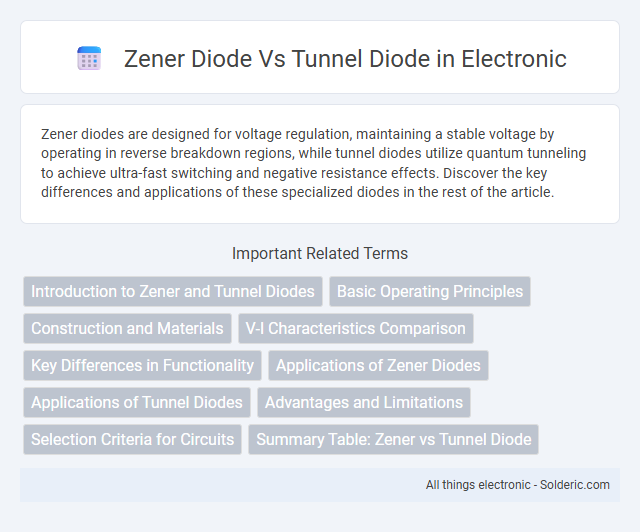Zener diodes are designed for voltage regulation, maintaining a stable voltage by operating in reverse breakdown regions, while tunnel diodes utilize quantum tunneling to achieve ultra-fast switching and negative resistance effects. Discover the key differences and applications of these specialized diodes in the rest of the article.
Comparison Table
| Feature | Zener Diode | Tunnel Diode |
|---|---|---|
| Operating Principle | Breakdown by Zener effect | Quantum tunneling effect |
| Application | Voltage regulation, voltage reference | High-speed switching, microwave oscillators |
| Voltage Range | Typically 2.4V to 200V | Low voltage operation, typically below 1V |
| Current Characteristics | Controlled breakdown current | Negative resistance region at low current |
| Speed | Relatively slower | Extremely high speed |
| Construction | Heavily doped PN junction | Heavily doped PN junction with thin depletion region |
| Symbol | Standard diode with a break line | Diode with negative resistance indication |
Introduction to Zener and Tunnel Diodes
Zener diodes and tunnel diodes serve distinct purposes in electronic circuits, with Zener diodes primarily used for voltage regulation due to their ability to maintain a stable reverse breakdown voltage. Tunnel diodes exhibit negative resistance behavior by exploiting quantum tunneling, enabling ultra-fast switching and high-frequency applications. Understanding the unique electrical characteristics of both diodes helps optimize your circuit design for reliability and performance.
Basic Operating Principles
Zener diodes operate by exploiting the Zener breakdown effect, allowing current to flow in reverse when the voltage exceeds a specific, precisely controlled value, making them ideal for voltage regulation. Tunnel diodes function based on quantum mechanical tunneling, where electrons pass through an energy barrier at very high speeds, resulting in a region of negative resistance useful in high-frequency oscillators. Understanding your circuit's application determines whether the stable voltage reference of a Zener diode or the fast switching capabilities of a tunnel diode is more appropriate.
Construction and Materials
Zener diodes are constructed using heavily doped semiconductor materials like silicon to create a thin depletion region, enabling controlled breakdown at specific voltages. Tunnel diodes are made with extremely high doping levels on both p-type and n-type sides, producing a very narrow depletion region that allows quantum tunneling. Your choice between these diodes depends on the required operation voltage and quantum effects, influenced by their distinct construction and material properties.
V-I Characteristics Comparison
Zener diodes exhibit a sharp breakdown voltage with a nearly constant reverse voltage, ideal for voltage regulation, while their forward voltage drop remains low. Tunnel diodes show a unique negative resistance region due to quantum tunneling, resulting in a peak and valley in the V-I curve, enabling high-speed switching and oscillation. Understanding these distinctions in V-I characteristics helps you select the appropriate diode for applications requiring stable voltage or high-frequency operation.
Key Differences in Functionality
Zener diodes primarily operate as voltage regulators by allowing current to flow in the reverse direction when a specific breakdown voltage is reached, maintaining a stable voltage across electronic circuits. Tunnel diodes exploit quantum mechanical tunneling, enabling them to exhibit negative resistance and switch at extremely high speeds, making them ideal for high-frequency oscillators and microwave applications. Unlike Zener diodes, which regulate voltage in a stable manner, tunnel diodes function as ultra-fast switches due to their unique current-voltage characteristics.
Applications of Zener Diodes
Zener diodes are widely used for voltage regulation in power supplies, ensuring stable output voltage despite fluctuations in input or load conditions. They are essential in surge protection circuits to prevent damage from voltage spikes and in waveform clipping and voltage reference applications for precise circuit control. Their ability to maintain a constant voltage makes them vital components in electronic devices requiring steady voltage levels.
Applications of Tunnel Diodes
Tunnel diodes are widely used in high-frequency oscillators, microwave amplifiers, and fast-switching circuits due to their negative resistance region and ultra-fast response times. These diodes are ideal for applications requiring stable, low-noise signal generation at microwave and terahertz frequencies. Your electronic designs benefit from the tunnel diode's ability to operate efficiently in high-speed and high-frequency environments where conventional diodes like Zener diodes may not perform optimally.
Advantages and Limitations
Zener diodes excel in voltage regulation with stable breakdown voltage and low noise, making them ideal for voltage reference and protection circuits, but they have slower response times and higher power dissipation compared to tunnel diodes. Tunnel diodes offer ultra-fast switching speeds and negative resistance properties beneficial for high-frequency oscillators and amplifiers, yet they suffer from low voltage operation thresholds and limited current handling capabilities. Both components serve specific niche applications, with Zener diodes preferred for voltage stabilization and tunnel diodes favored in microwave and high-speed switching domains.
Selection Criteria for Circuits
Zener diodes are chosen for circuits requiring precise voltage regulation and stable reference voltages due to their reliable reverse breakdown characteristics. Tunnel diodes are preferred in high-frequency oscillators and switching circuits for their negative resistance region and extremely fast response times. Selection depends on whether voltage stabilization or high-speed switching is the primary circuit function.
Summary Table: Zener vs Tunnel Diode
Zener diodes operate in the breakdown region to provide voltage regulation with a sharp breakdown voltage typically between 2.4V and 7V, while tunnel diodes utilize quantum tunneling to achieve negative resistance in the low voltage range around 0.1V to 0.3V. Zener diodes have moderate switching speeds suitable for voltage clamping and protection, whereas tunnel diodes offer extremely high-speed switching capabilities ideal for microwave and high-frequency oscillators. The maximum current rating for Zener diodes generally spans from a few milliamps up to several amperes, contrasting with tunnel diodes which handle lower currents usually less than 100mA, emphasizing distinct applications in power regulation versus high-speed signal generation.
Zener diode vs tunnel diode Infographic

 solderic.com
solderic.com